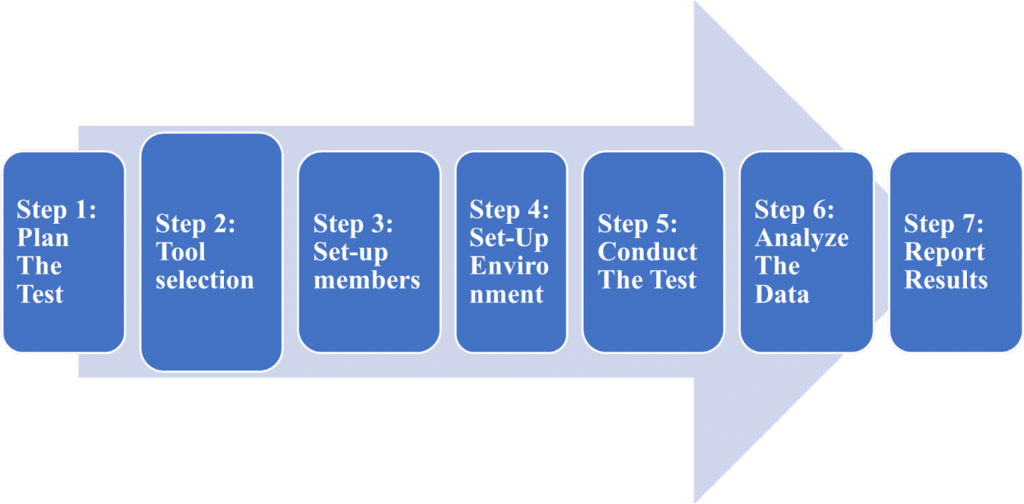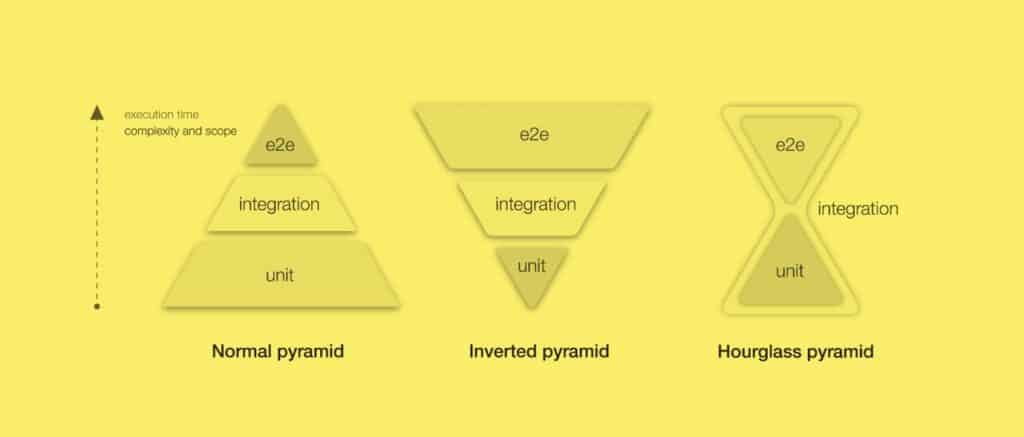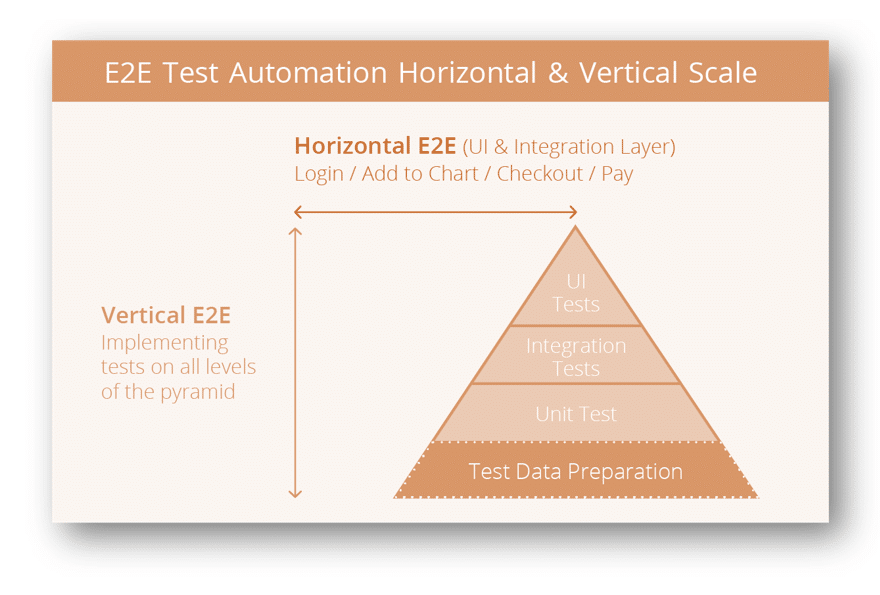End-To-End User Testing Complete Guide & Frameworks
End-to-end testing identifies potential issues during system component integration and ensures proper system functionality. By testing the system in its entirety, E2E testing provides a more realistic representation of how the system will perform in a real-world scenario.
It also helps to catch any bugs or errors that may have been missed in other testing phases – such as: unit or integration testing. End-to-end testing frameworks results are used to improve the quality of the product and increase its reliability and usability for end users.

All you need to know about end-to-end user testing frameworks
End-to-end user testing framework provides a testing process that involves evaluating a product or system from the user’s perspective, from start to finish. The goal of end-to-end user testing is to identify any issues or problems that users may encounter while using the product and to ensure that the product meets the users’ needs and expectations.
This testing covers all aspects of the product, including its design, functionality, performance and overall user experience. It is typically performed on a representative sample of users to get a broad view of how the product will perform for different types of users.
End-to-end user testing can be performed in various ways, including manual testing, automated testing, and crowd-sourced testing. The results of end-to-end user testing provide valuable feedback to the development team, helping them to improve the product and ensure that it meets the needs of the target user base.
What Is End-to-End Testing?
The goal of end-to-end testing is to identify any issues that may arise when the components of the system are integrated and to ensure that the system functions as intended. By testing the system in its entirety, E2E testing provides a more realistic representation of how the system will perform in a real-world scenario.
End-to-end testing improves the quality, reliability, and usability of a product and catches any bugs or errors that may have been missed in other testing phases – such as: unit or integration testing.
Why There Is A Need To Perform End-to-End Testing?

Suppose there is any failure or issue in any sub-system. Then, it will adversely affect the complete software system which leads to collapse. These are some significant risks that should be avoided and can be controlled by this testing.
- You have to keep checking and then perform system flow verification.
- Increase the coverage of test areas of all the subsystems that are involved with the system software.
- It will help to detect issues if there are any subsystems and then increases the productivity of the entire system.
Apart from this, there are separate front end testing frameworks and back-end testing frameworks. For example: Mocha JS, Jest, Jasmine, Karma, Nightwatch JS and Puppeteer are the best front end testing frameworks based on JavaScript.
Activities included in the end-to-end testing process
The study of requirements performs at the time of testing. There is a proper setup of the test environment which should include the below-mentioned list of activities:
- Defining test cases and test scenarios
- Test environment setup
- Test data preparation
- Test execution
- Test results analysis
- Test report generation
- Test closure and maintenance
- Defect reporting and tracking
- Test automation
- Test regression.
Working on End-To-End Testing frameworks
Involves designing and implementing frameworks that validate the complete functionality of a system. This includes simulating real-world scenarios to identify any integration issues and ensure that the system meets its requirements. The frameworks test the entire application flow, including the UI, APIs, and back-end system and verify the system’s response to different inputs.
The frameworks catch any bugs or errors that may have been missed in other testing phases by doing so. The goal of working on End-to-End Testing frameworks is to improve product quality and reliability, as well as increase the system’s usability for end-users.
The working of the end-to-end testing frameworks incorporates the following steps:
- Design and implement E2E testing frameworks
- Validate complete system functionality
- Simulate real-world scenarios
- Identify integration issues
- Ensure the system meets the requirements
- Test the entire application flow, including UI, APIs, and back-end
- Verify system response to different inputs
- Catch bugs or errors missed in other testing phases
- Improve product quality and reliability
- Increase system usability for end-users.
Categories of End-to-End Testing

There are several categories of end-to-end testing, each serving a specific purpose and providing valuable insights into the system’s functionality. One common category is functional testing, which verifies that the system functions as intended by performing various tasks and comparing the results to expected outcomes.
Another category is performance testing, which measures the system’s speed, stability, and scalability under different conditions. Security testing is another important category, which evaluates the system’s ability to protect sensitive data and prevent unauthorized access.
Usability testing is also a key category, which assesses the ease of use and overall user experience of the system. These categories, when combined, provide a comprehensive view of the system’s capabilities and help to ensure that the system meets its requirements and performs as expected for end-users.
Moreover, many developers are shifting towards the react applications process. So, you need to opt for the best end-to-end testing frameworks for React to make sure that your application should work effectively.
Horizontal Testing
Horizontal testing is a type of software testing that focuses on the overall functionality and performance of a system, rather than testing individual components in isolation. This type of testing evaluates the system’s interactions with other systems and its ability to handle different inputs and scenarios.
Horizontal testing is often performed using testing frameworks, which are pre-built structures that provide a systematic approach for evaluating the system’s performance. These frameworks can include functional testing, performance testing, security testing, and usability testing, among others.
By using testing frameworks for horizontal testing, organizations can improve the efficiency and effectiveness of their testing processes, and ensure that the system meets the needs of end users.
Vertical Testing
The approach of vertical testing is different from the approach of horizontal testing. By considering the example mentioned above, each component has a complete process. Suppose a login or sign-up process can have direct logging in by entering the user’s information. Even you can log in through Google or Facebook.
You can validate by email and choosing a password. So vertical testing mainly focuses on the depth of each component and features of the product. In this, all the complex scenarios require proper validation testing. That’s why this method is quite tricky.
Continuous Testing: How to Implement it in Your Development Cycle
Guidelines to follow while developing vertical testing test cases
- Test cases must be developed from the user’s perspective.
- It should focus on testing some existing features.
- In these cases, multiple techniques should be considered for different types of test cases.
- There are different sets of test cases that should be created to focus on various system scenarios.
Now you all have a clear idea about the end-to-end testing. By moving forward, we will discuss the frameworks used for the end-to-end testing process.
What are the Frameworks of End-to-End Testing?
End-to-end automation testing framework play a crucial role in ensuring that a system functions as intended and meets end-user requirements. By utilizing these frameworks, organizations can facilitate efficient testing processes that improve the overall functionality and performance of the system.
These frameworks help to identify and resolve any integration issues, ensuring that the system functions smoothly and effectively. Ultimately, end-to-end testing frameworks provide organizations with a comprehensive view of the system’s capabilities and help to ensure that the system meets the needs of end-users. By leveraging these frameworks, organizations can build systems that are robust, reliable, and fit for purpose.
- Protractor: Validates AngularJS applications’ functionality, leveraging Angular-specific features like two-way data binding.
- Cypress: Streamlines testing experience for front-end and back-end developers by testing web applications holistically.
- Selenium: Automates web applications using multiple programming languages and browser platforms.
- Nightwatch: Simplifies browser automation and testing process.
- Jest: Tests JavaScript, commonly used with React applications, with end-to-end testing capabilities.
Best Test Automation Frameworks
For automation as well as manual testing, there are the best end-to-end testing frameworks available for both testing methods.
1. Selenium WebDriver
It is a popular open-source framework for automating web applications. It supports multiple programming languages – such as: Java, Python, C#, etc. and multiple browsers like Chrome, Firefox, Safari, etc. Selenium WebDriver allows you to write scripts to simulate user interactions with a web application and perform various tests, such as verifying UI elements, checking the response time, etc.
2. Cypress
Cypress is a JavaScript-based end-to-end testing framework for web applications. It provides a user-friendly interface for writing and running tests. One of the key benefits of using Cypress is its ability to interact directly with the browser, making it faster and more reliable than other frameworks that rely on a proxy.
3. Protractor
Protractor is a Node. js-based end-to-end testing framework for Angular applications. It is specifically designed to test Angular applications and provides features such as automatic waiting, evaluation of Angular-specific elements, etc.
4. Playwright
Playwright is a Node. js based end-to-end testing framework for web applications that supports multiple browsers, including Chromium, Firefox, and WebKit. It provides an easy-to-use API for automating browser actions and asserting the state of the application.
5. Appium
Appium is a cross-platform open-source framework for automating native, mobile web, and hybrid applications. It supports multiple platforms, including Android and iOS, and provides a convenient API for automating user interactions with a mobile application.
These are just some of the popular end-to-end testing frameworks. It’s important to choose a framework that best fits your testing requirements and your development environment.
Read more about: Static Application Security Testing: SAST Basics
Which Framework is best for you?
The best end-to-end testing framework for you depends on several factors – such as:
- Application type: The type of application you are testing- such as: a web application, mobile application, or desktop application.
- Platform: The platform you are developing – such as: Android or iOS will also influence your choice of framework.
- Programming language: The programming language you are using for development – such as: Java, Python, JavaScript, etc. It will determine which frameworks are compatible with your development environment. On the bases of the programming language, you need to make a concise decision about the best end-to-end testing framework for angular applications as well as the best end-to-end testing framework for react applications.
- Test requirements: The specific testing requirements need to be clearly mentioned out during the development process. For example: the types of tests you need to perform, supportive browsers, the speed and reliability of the tests. All these frameworks will determine about the best framework for you.
Based on these factors, you can make an informed decision on which end-to-end testing framework is best for you. It’s also a good idea to consider trying out multiple frameworks and conducting a comparison to determine the one that works best for your specific use case.
The Final Words
By reading this, we hope that you understand all the aspects of end-to-end tests. So it is important for any commercial release of software and plays an important role for end-to-end verifications. It is because it’s tests the application entirely for its environment that attract users like communication and interaction.
At Amplework, we incorporate innovative functionalities to perform the end-to-end testing frameworks to ensure that the software should deliver optimum performance measures.



 sales@amplework.com
sales@amplework.com
 (+91) 9636-962-228
(+91) 9636-962-228





